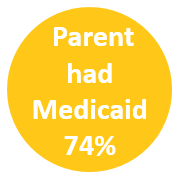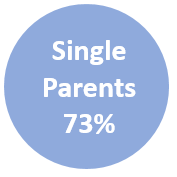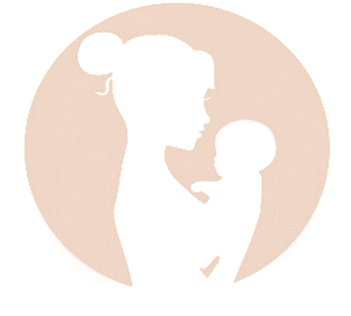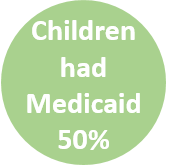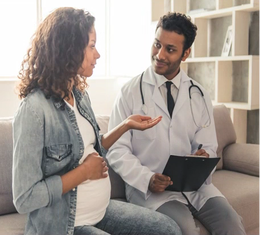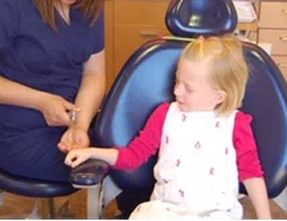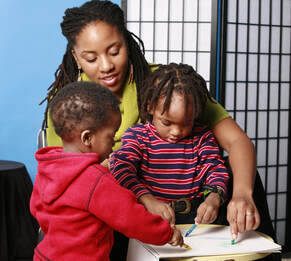- About Promise 1000
- Parental Supports
- Success Stories
- Promise 1000 Outcomes
- Safe Infant Sleep
- Home Visiting Research
- Fiscal Sustainability Summit
- Funders
- "Did You Know" - Immunizations
- "Did You Know" - Tips for Managing Temper Tantrums & Parental Stress
- "Did You Know" - Pregnancy & Infant Loss Awareness
- "Did You Know" - COVID-19
- "Did You Know" - Child Safety
- "Did You Know" - The Importance of Tracking Baby's Movement during Pregnancy!
Maternal Health & Well-Being
- Maternal Healthcare Goals. Mothers creating, and having on-going, health care goals for themselves increased 58% over this reporting period
- Maternal Depression. Mothers receiving on time screens for depression increased 40% from 2016 to 2019
- Mothers often screened low risk for depression overall or moved towards a lower risk over time
- Of the 170 that indicated depression at some point, 49% moved towards a lower risk of depression
- 235 mothers total were referred to supportive services through Moving Beyond Depression™ from 2017-2019
- Every Child Succeeds reports the Promise 1000 MBD program is a strong program and includes a high percentage of moms (85%) recovering pre and post treatment, significant drops in parental stress, and a substantial increase in social support over time
- Healthcare Education. Most recently during this period, 87%-88% of caregivers discussed healthcare utilization and reproductive life planning options with their home visitors
- Substance Use. A relatively small percentage of mothers reported using substances (4% during pregnancy and 5% within the first 6 months of birth) with about 15% indicating tobacco use at enrollment.*
Child Health & Well-Being
- Breastfeeding. Average breastfeeding duration - 11 months with families participating in home visitation breastfeeding almost 1x longer than the desired norm (6 months)
- Child Healthcare Goals. Most recently during this period, 87% of caregivers created, and had an on-going, S.M.A.R.T health care goal for their child
- Birth Outcomes. Of the infants that were born to families enrolled in home visiting prior to the infants birth: 93% were born at healthy birth weight, and 91% were full term births
- Infant Mortality. During the 3 year period, the infant mortality rate for families involved with home visiting was 2.9 per 1,000 Children (<1%)
- Well-Child Checks. Promise 1000 home visitors encourage families to attend well child visits and offer supportive coordination of care by attending well child visits with families
- On average, 62% were of families were attending their well child checks on time (following the recommended AAP schedule).
- The longer the family was involved with home visiting the better their well child check attendance rates.
Child Development & School-Readiness
- Child Development. Home Visiting Agencies completed 4,817 child development screenings over the 3 year period.
- Screening identifies needs in the following areas of child development: 1) Communication, 2) Gross Motor, 3) Fine Motor, 4) Problem-Solving, and 5) Personal-Social
- 67% of children had a potential need for developmental services in 1 developmental area, 19% in two areas, 11% in 3-4 areas, and 3% in all 5 areas
- Home visitors achieved a 44% increase in on time screenings over time
- Screening identifies needs in the following areas of child development: 1) Communication, 2) Gross Motor, 3) Fine Motor, 4) Problem-Solving, and 5) Personal-Social
- Child Social-Emotional Development. Infants and children were additionally screened for child social-emotional development and growth (a 30% increase in on time screens was achieved)
- Social-Emotional screens indicated a potential need for services in 5% of children and suggested monitoring for delays in 7% of the children
- Child Development - Protective Factors. Families involved with home visiting demonstrated strong protective factors and skills regarding knowledge and understanding of child development
- Parent-Child Interactions. Strong or frequent positive parenting behaviors were observed in all 4 domains of the parent-child interaction tool (Affection, Responsiveness, Encouragement, and Teaching)
- The strongest positive behaviors were seen in the Affection and Responsiveness domains followed by the Encouragement domain
- Literacy Activities. Initial results suggest that a high percentage of caregivers (91%) indicate that an adult in their household reads, tells stories, and/or sings songs to their child on a daily basis
- Early Education Connection. Upon completion of the Promise 1000 program (age 3 years) home visitors are able to refer families to early education services and preschool
Home Safety & Family Resilience
- Home Environment Safety. A 30% increase in families screened on time for home safety to promote safe living environments, safe sleep, and safe traveling was seen during the reporting period (14 areas of home safety are considered)
- The average number of home safety concerns reported were relatively low initially and over time
- Additionally, a low percentage of families screened positive for intimate partner violence
- Protective Factors. Protective Factors strengthen families and encourage positive parenting practices (a 28% increase in on time protective factors screens was achieved over the reporting period).
- Overall, results suggest home visiting families have strong protective factors with the strongest results in the areas of social supports, nurturing/attachment, child development, and discipline/positive parenting over time
- Families had moderately strong protective factors in the areas of family functioning/resiliency and concrete needs
- Emergency Department (ED) Visits. 4% of children had at least one injury-related ED visit (4 per 100 children)
- The average age at the time of the ED visit was 1 year 2 months of age; which corresponds with children walking and toddling (a time when more accidental injuries occur)
- Results suggested that less injury-related ED visits occurred later in the Promise 1000 program (when the child had reached 2-3 years of age)
- Safe Infant Sleep. Promise 1000 managed and developed The Missouri First Birthday project in the Kansas City region. The project occurred January 2019-June 2020, and resulted in 256 families receiving safe infant sleep education, pack n plays, and safe sleep materials through 9 community partners. Project results include:
- Families achieved a 96% on a safe sleep knowledge assessment after they received safe sleep education
- Families had an average increase in safe sleep practices of 8% from the initial observation of the sleep environment to the last observation (81% pre/89% post)
- There were substantial increases in families using a crib or pack-n-play for their babies sleeping location instead of unsafe sleep locations (mattresses, couch’s, car seats, etc.)
- Decreases were seen in families placing unsafe items in the sleeping area (blankets, toys, pillows, bumper pads, etc.) with the largest decrease in blankets or loose bedding (28% to 7%)
- There was increase in baby sleeping alone and decreases in children sleeping on their side/stomach
- Overall, Children's Mercy staff trained 50 professionals in safe infant sleep practices, 100% of families received safe sleep education, and 99% of families received a safe sleep crib, materials and supplies (1% had supplies already)
Additional triennial results can be found in a report coming soon!
Promise 1000 Outcomes
Promise 1000 Presentations & Documents
|
| ||||||||||||
| |||||||
© COPYRIGHT 2017. ALL RIGHTS RESERVED.
- About Promise 1000
- Parental Supports
- Success Stories
- Promise 1000 Outcomes
- Safe Infant Sleep
- Home Visiting Research
- Fiscal Sustainability Summit
- Funders
- "Did You Know" - Immunizations
- "Did You Know" - Tips for Managing Temper Tantrums & Parental Stress
- "Did You Know" - Pregnancy & Infant Loss Awareness
- "Did You Know" - COVID-19
- "Did You Know" - Child Safety
- "Did You Know" - The Importance of Tracking Baby's Movement during Pregnancy!

